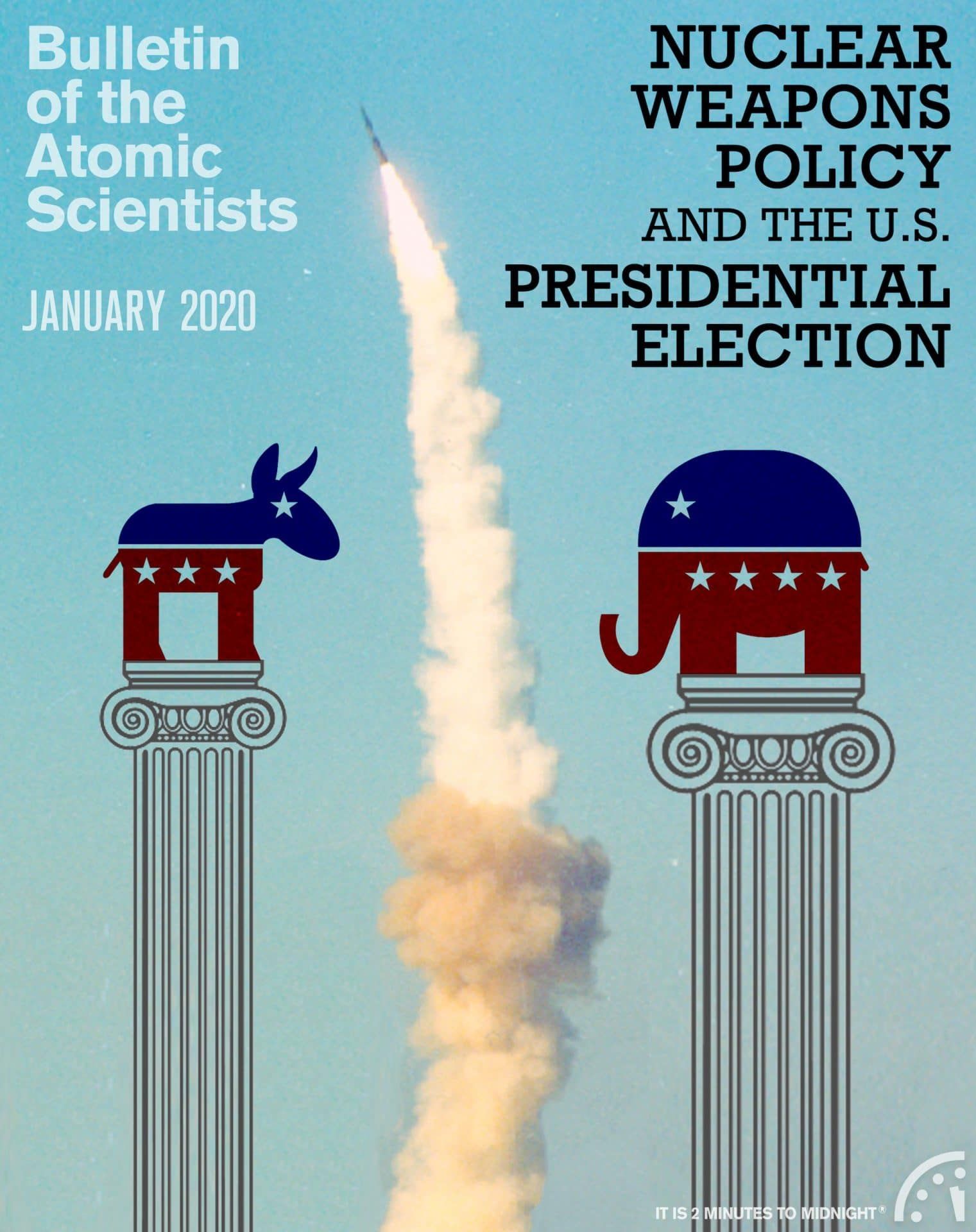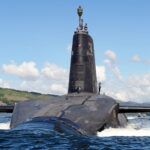Nuclear Notebook: United States nuclear forces, 2020
By Hans M. Kristensen, Matt Korda | January 1, 2020
Nuclear Notebook: United States nuclear forces, 2020
By Hans M. Kristensen, Matt Korda | January 1, 2020
Editor’s note: The Nuclear Notebook is researched and written by Hans M. Kristensen, director of the Nuclear Information Project with the Federation of American Scientists, and Matt Korda, a research associate with the project. The Nuclear Notebook column has been published in the Bulletin of the Atomic Scientists since 1987.
To download a free PDF of this article, click here.
To see all previous Nuclear Notebook columns, click here.
At the beginning of 2019, the US Department of Defense maintained an estimated stockpile of 3,800 nuclear warheads for delivery by 800 ballistic missiles and aircraft. Most of the warheads in the stockpile are not deployed, but rather stored for potential upload onto missiles and aircraft as necessary. Many are destined for retirement. We estimate that approximately 1,750 warheads are currently deployed, of which roughly 1,300 strategic warheads are deployed on ballistic missiles and another 300 at strategic bomber bases in the United States. An additional 150 tactical bombs are deployed at air bases in Europe. The remaining warheads—approximately 2,050—are in storage as a so-called hedge against technical or geopolitical surprises. Several hundred of those warheads are scheduled to be retired before 2030. (See Table 1.)
In addition to the warheads in the Defense Department stockpile, approximately 2,000 retired—but still intact—warheads are stored under custody of the Department of Energy and are awaiting dismantlement, giving a total US inventory of an estimated 5,800 warheads. Between 2010 and 2018, the US government publicly disclosed the size of the nuclear weapons stockpile. But in 2019, the Trump administration rejected a request from the Federation of American Scientists to declassify the latest stockpile number (Aftergood 2019, Kristensen 2019a).

US Nuclear Forces Full Table 1
The nuclear weapons are thought to be stored at an estimated 24 geographical locations in 11 US states and five European countries. The location with the most nuclear weapons by far is the large Kirtland Underground Munitions and Maintenance Storage Complex south of Albuquerque, NM. Most of the weapons in this location are retired weapons awaiting shipment for dismantlement at the Pantex Plant in Texas. The state with the second-largest inventory is Washington, which is home to the Strategic Weapons Facility Pacific and the ballistic missile submarines at Naval Submarine Base Kitsap (Washington is the state with most nuclear weapons if counting only stockpiled weapons). Of the five nuclear weapons storage locations in Europe, Incirlik Air Base in Turkey stores the most—about one-third of the weapons in Europe. However, given the recent upswing in tensions with Turkey, US officials have reportedly reviewed plans to potentially quietly withdraw the nuclear weapons from Incirlik (Sanger 2019). If the United States decided to do so, it would require the use of C-17 transport aircraft from the 4th Airlift Squadron based at Joint Base Lewis-McChord in Washington––the only unit in the Air Force that is qualified to airlift nuclear weapons.
Implementing New START
The United States appears to be in compliance with the New START treaty limits, with 668 deployed strategic launchers with 1,376 attributed warheads counted as of September 1, 2019, well below the limits of 700 deployed strategic launchers with 1,550 warheads. Another 132 launchers were not deployed, for a total inventory of 800 deployed and non-deployed launchers (State Department 2019a). This represents a slight increase from last March’s declaration of 656 strategic launchers with 1,365 attributed warheads (State Department 2019b), fluctuations that reflect normal maintenance of launchers. These numbers differ from the estimates presented in this Nuclear Notebook because the New START counting rules artificially attribute one warhead to each deployed bomber, even though US bombers do not carry nuclear weapons under normal circumstances, and because this Nuclear Notebook counts weapons stored at bomber bases that can quickly be loaded onto the aircraft.
Since the treaty entered into force in February 2011, the bi-annual aggregate data show the United States has cut a total of 214 deployed launchers and 424 deployed strategic warheads. The Department of Defense has also completed the destruction of non-deployed launchers and conversion of 97 launchers to non-nuclear status.
The 2018 Nuclear Posture Review states that the United States “will continue to implement the New START Treaty” while it remains in effect (Department of Defense 2018, 73). The treaty will remain in effect until February 2021, at which point it may be extended for up to five years with mutual agreement. The Trump Administration has not yet indicated whether it will seek to extend the treaty; however, prospects for extension appear to be somewhat grim, given underlying concerns over how Russia’s new strategic systems might be counted under the treaty, in addition to the Trump administration’s open disdain for arms control agreements.
The United States is currently 32 launchers and 174 warheads below the treaty limit for deployed strategic weapons, while Russia is currently 187 launchers and 124 warheads below the treaty limits.
If New START were allowed to expire, both Russia and the United States could upload several hundreds of extra warheads onto their launchers, which means that the treaty has proven useful thus far in keeping a lid on both countries’ nuclear modernization plans. Additionally, if New START expired, then both countries would lose a critical node of transparency into each other’s nuclear forces: to date, the United States and Russia have completed a combined 317 on-site inspections (29 this year) and exchanged 19,025 notifications (State Department 2019c).
The Nuclear Posture Review and nuclear strategy
Although the Trump administration’s 2018 Nuclear Posture Review (NPR) followed the broad outlines of the Obama administration’s 2010 NPR to modernize the entire nuclear weapons arsenal, it includes several important changes.
The most significant change is a recommendation to increase the types and role of US nuclear weapons. The Trump NPR takes a confrontational tone, presenting an assertive posture that embraces “Great Power competition,” and includes plans to develop new nuclear weapons and modify others. The report backs away from the goal of seeking to limit the role of nuclear weapons to the sole purpose of deterring nuclear attacks, and instead emphasizes “expanding” US nuclear options to deter, and, if deterrence fails, to prevail against both nuclear and “non-nuclear strategic attacks.” To be clear, any use of a nuclear weapon to respond to a non-nuclear strategic attack would constitute nuclear first use.
The NPR explains that “non-nuclear strategic attacks include, but are not limited to, attacks on the U.S., allied, or partner civilian population or infrastructure, and attacks on U.S. or allied nuclear forces, their command and control, or warning and attack assessment capabilities” (Department of Defense 2018, 21). US nuclear capabilities will be postured to “hedge against the potential rapid growth or emergence of nuclear and non-nuclear strategic threats, including chemical, biological, cyber, and large-scale conventional aggression” (Department of Defense 2018, 38). To achieve these goals, the NPR states that “the United States will enhance the flexibility and range of its tailored deterrence options. … Expanding flexible US nuclear options now, to include low-yield options, is important for the preservation of credible deterrence against regional aggression,” the report claims (Department of Defense 2018, 34).
The new tailored capabilities include modifying “a small number” of the existing W76-1 90-kiloton two-stage thermonuclear warheads to single-stage warheads by “turning off” the secondary to limit the yield to what the primary can produce (an estimated 5-7 kilotons). This new capability, the NPR claims, is necessary to “help counter any mistaken perception of an exploitable ‘gap’ in US regional deterrence capabilities.”
In the longer term, the NPR declares that the United States will also “pursue a nuclear-armed” submarine-launched cruise missile to “provide a needed nonstrategic regional presence, an assured response capability, and [in view of] Russia’s continuing… violation” of the Intermediate-Range Nuclear Forces Treaty (INF Treaty), a response that itself is compliant with the treaty. In pursuit of this new missile, the review states “we will immediately begin efforts to restore this capability by initiating a requirements study leading to an Analysis of Alternatives … for the rapid development of a modern [submarine-launched cruise missile].” The report’s authors believe that “US pursuit of a submarine-launched cruise missile may provide the necessary incentive for Russia to negotiate seriously a reduction of its nonstrategic nuclear weapons, just as the prior Western deployment of intermediate-range nuclear forces in Europe led to the 1987 INF Treaty” (Department of Defense 2018, 55). Despite these efforts to respond to Russia’s INF treaty violation in a treaty-compliant manner, the Trump Administration in February 2019 announced its decision to withdraw from the INF Treaty. So far, though, all of the land-based weapons proposed to counter Russia are conventional (Sonne 2019).
The new nuclear “supplements” proposed by the NPR are needed, the authors say, to “provide a more diverse set of characteristics greatly enhancing our ability to tailor deterrence and assurance; expand the range of credible US options for responding to nuclear or non-nuclear strategic attack; and, enhance deterrence by signaling to potential adversaries that their concepts of coercive, limited nuclear escalation offer no exploitable advantage” (Department of Defense 2018, 55).
Yet the US arsenal already includes around 1,000 gravity bombs and air-launched cruise missiles with low-yield warhead options (Kristensen 2017a). The NPR provides no evidence that existing capabilities are insufficient or document that the yield of US nuclear weapons is a factor in whether Russia would decide to use nuclear weapons. The NPR authors simply claim that the new capabilities are needed. The US Navy used to have a nuclear submarine-launched cruise missile (the TLAM/N) but retired it in 2011 because it was redundant and no longer needed. All other nonstrategic nuclear weapons—with the exception of gravity bombs for fighter-bombers—have also been retired because there is no longer any military need for them, despite Russia’s larger nonstrategic nuclear weapons arsenal.
The suggestion that a US submarine-launched cruise missile could motivate Russia to return to compliance with the Intermediate-Range Nuclear Forces (INF) Treaty is flawed because Russia embarked upon its current violation of the treaty at a time when the TLAM/N was still in the US arsenal, and because the Trump administration has since withdrawn the United States from the INF treaty. Moreover, US Strategic Command has already strengthened strategic bombers’ support of NATO in response to Russia’s more provocative and aggressive behavior; 46 B-52 bombers currently are equipped with the air-launched cruise missile (ALCM) and both the B-52 and the new B-21 bomber will receive the new long-range standoff (LRSO) weapon, which will have essentially the same capabilities as the SLCM proposed in the NPR.
Russia’s decisions about the size and composition of its nonstrategic arsenal appear to be driven by Washington’s superiority in conventional forces, not by the US nonstrategic nuclear arsenal or by the yield of a particular weapon. Instead, pursuit of a new nuclear SLCM to “provide a needed nonstrategic regional presence” in Europe and Asia could—especially when combined with the parallel expansion of US long-range conventional strike capabilities including development of new conventional INF-range missiles—strengthen Russia’s reliance on nonstrategic nuclear weapons and could potentially even trigger Chinese interest in such a capability as well.
Nuclear-capable vessels triggered frequent and serious political disputes during the Cold War when they visited foreign ports in countries that did not allow nuclear weapons on their territory; in the case of New Zealand, diplomatic relations have only recently—30 years later—recovered from those disputes. Reconstitution of a nuclear SLCM would reintroduce this foreign relations irritant and needlessly complicate relations with key allied countries in Europe and Northeast Asia.
According to an estimate published in January 2019 by the US Congressional Budget Office (CBO), modernizing and operating the US nuclear arsenal and the facilities that support it will cost around $494 billion for the period 2019–2028 (Congressional Budget Office 2019, 1). This is $94 billion more than CBO’s 2017 estimate for the 2017–2026 period, in part because modernization programs continue to ramp up, cost estimates are increasing, and because of the NPR’s call for new nuclear weapons. The nuclear modernization (and maintenance) program will continue well beyond 2028 and, based on the CBO’s estimate, will cost $1.2 trillion over the next three decades. Notably, although the CBO estimate accounts for inflation (Congressional budget Office 2017), other estimates forecast that the total cost will be closer to $1.7 trillion (Arms Control Association 2017). Whatever the actual price tag will be, it is likely to increase over time, resulting in increased competition with conventional modernization programs planned for the same period. The NPR belittles concerns about affordability issues in the nuclear modernization program and instead labels it “an affordable priority,” pointing out that the total cost is only a small portion of the overall defense budget (Department of Defense 2018, XI). There is little doubt, however, that limited resources, competing nuclear and conventional modernization programs, tax cuts, and the rapidly growing deficit will present significant challenges for the nuclear modernization program.
Nuclear planning, nuclear exercises
The changes in the Trump administration’s Nuclear Posture Review so far do not appear to have required new guidance from the White House on nuclear weapons strategy. The previous guidance, issued in 2013, also reaffirmed the importance of nuclear weapons and modernization and emphasized a strong counterforce strategy—planning principles that have already been incorporated into a host of highly flexible strategic and regional nuclear strike plans (Kristensen 2013a).
These strike plans are incorporated into a “family” of plans organized under the strategic “Operations Plan (OPLAN) 8010-12,” and also into various regional plans. The OPLAN, which is named Strategic Deterrence and Force Employment and first entered into effect in July 2012 in response to Operations Order (OPORD) Global Citadel signed by the secretary of defense, is flexible enough to absorb normal changes to the posture as they emerge, including those flowing from the NPR. Several updates have been published since 2012. OPLAN 8010-12 is part of a broader plan that also includes conventional weapons such as the Tactical Tomahawk submarine-launched cruise missile and the extended-range Joint Air-to-Surface Standoff Missile, as well as missile defense and cyber. OPLAN 8010-12 includes strike options against Russia, China, North Korea, and Iran. Although the Trump administration’s NPR criticizes Russia for an alleged willingness to use nuclear weapons first as part of a so-called escalate-to-deescalate strategy, OPLAN 8010-12 also “emphasizes escalation control designed to end hostilities and resolve the conflict at the lowest practicable level” by developing “readily executable and adaptively planned response options to de-escalate, defend against, or defeat hostile adversary actions” (US Strategic Command 2012). This objective is not just directed at nuclear attacks, as the 2018 NPR calls for “expanding” US nuclear options against “non-nuclear strategic attacks.”
The strategic war plan is a whole-of-government plan that includes the full spectrum of national power to affect potential adversaries. This integration of nuclear and conventional kinetic and non-kinetic strategic capabilities into one overall plan is a significant change from the strategic war plan of the Cold War, which was almost entirely nuclear. Former STRATCOM commander Gen. John Hyten, now the Chairman of the Joint Chiefs of Staff, in 2017 explained the scope of modern strategic planning:
I’ll just say that the plans that we have right now, one of the things that surprised me most when I took command on November 3 was the flexible options that are in all the plans today. So we actually have very flexible options in our plans. So if something bad happens in the world and there’s a response and I’m on the phone with the secretary of defense and the president and the entire staff, which is the attorney general, secretary of state, and everybody, I actually have a series of very flexible options from conventional all the way up to large-scale nuke that I can advise the president on to give him options on what he would want to do.
So I’m very comfortable today with the flexibility of our response options. Whether the president of the United States and his team believes that that gives him enough flexibility is his call. So we’ll look at that in the Nuclear Posture Review. But I’ve said publicly in the past that our plans now are very flexible.
And the reason I was surprised when I got to [Strategic Command] about the flexibility, is because the last time I executed or was involved in the execution of the nuclear plan was about 20 years ago, and there was no flexibility in the plan. It was big, it was huge, it was massively destructive, and that’s all there. We now have conventional responses all the way up to the nuclear responses, and I think that’s a very healthy thing (Hyten 2017).
To practice and fine-tune these plans, the armed forces conducted several nuclear-related exercises in 2019. These included STRATCOM’s Global Lightning exercise in March, a command and control and battle staff exercise that focused on supporting US European Command (USEUCOM). Global Lightning was part of a Globally-Integrated Exercise that linked to several other exercises: USEUCOM’s Exercise Austere Challenge, US Cyber Command’s Exercise Cyber Lightning, North American Aerospace Defense Command and US Northern Command’s Exercise Vigilant Shield, US Transportation Command’s Exercise Turbo Challenge, the Joint Chiefs of Staff Exercise Positive Response, and the United Kingdom’s Exercise Joint Venture (US Strategic Command 2019a). At the start of Global Lightning, four B-52s deployed to RAF Fairford in England (two more joined later) for month-long operations over Europe, unprecedented four-bomber strike formations over the eastern Baltic Sea (US Air Forces In Europe 2019a) and north along the Norwegian coast (US Air Forces In Europe 2019b).
Strategic bombers returned to Europe over the summer, and in September participated in the first-ever operations of B-2 bombers above the Arctic Circle (US Air Forces In Europe 2019c) as well as a landing in Iceland (US Strategic Command 2019c).
STRATCOM’s Global Thunder exercise in October brought bombers to Europe once more. The large-scale exercise had a focus on nuclear operations and was designed “to test readiness and ensure a safe, secure, ready and reliable strategic deterrent force” (US Strategic Command 2019b). Noticeable bomber operations during the exercise included an unprecedented three-aircraft B-52 formation flying north of Norway deep into the Barents Sea only about 300 kilometers (200 miles) from Russia’s naval base on the Kola Peninsula. Another mission involved two B-52s escorted by Polish F-16s over Poland in what appeared to be a simulated strike mission against Russian forces in Kaliningrad. In addition to the bombers deployed in Europe, Global Thunder also included bombers taking off from their bases back in the United States to simulate long-range strikes against Russia. Moreover, STRATCOM said Global Thunder also exercised ICBM and SSBN forces “in new and challenging ways” (US Strategic Command 2019d).
These operations mark a peak in steadily increasing US bomber operations in Europe since Russia’s invasion of Ukraine in 2014. Before that, one or two bombers would deploy for an exercise or airshow. But since then, the number of deployments and bombers have increased, and the mission changed. Very quickly after the Russian annexation of Crimea, STRATCOM increased the role of nuclear bombers in support of EUCOM (Breedlove 2015), which in 2016 put into effect a new standing war plan for the first time since the Cold War (Scaparrotti 2017). Before 2018, the bomber mission was called the Bomber Assurance and Deterrence missions to show the flag, but now the bombers deploy as a Bomber Task Force that brings the full offensive capability to the forward base. Whereas the mission of Bomber Assurance and Deterrence was to train with allies and have a visible presence to deter Russia, the mission of the Bomber Task Force is to move a fully combat ready bomber force into the European theater. “It’s no longer just to go partner with our NATO allies, or to go over and have a visible presence of American air power,” according to the commander of the 2nd Bomb Wing. “That’s part of it, but we are also there to drop weapons if called to do so” (Wrightsman 2019).
These changes are important indications of how US strategy has changed in response to deteriorating East-West relations and the new “Great Power competition” strategy promoted by the Trump administration. They also illustrate a growing integration of nuclear and conventional capabilities that is frequently overlooked. The deployment of four B-52s to RAF Fairford in March 2019, for example, included two nuclear-capable aircraft and two that have been converted to conventional-only missions. NATO’s official announcement of the exercise did not notice this feature but said the deployment “shows that the US nuclear umbrella protects Europe…” (NATO 2019). The statement also said that the B-52 bombers “can carry both conventional and nuclear weapons” when, in fact, nearly half of them—41 of 87—cannot because they have been denuclearized under the New START treaty. The close integration of nuclear and conventional bombers into the same task force can have significant implications for crisis stability, misunderstandings, and the risk of nuclear escalation.
Land-based ballistic missiles
The US Air Force operates a force of 400 silo-based Minuteman III ICBMs split across three wings: the 90th Missile Wing at F. E. Warren Air Force Base in Colorado, Nebraska, and Wyoming; the 91st Missile Wing at Minot Air Force Base in North Dakota; and the 341st Missile Wing at Malmstrom Air Force Base in Montana. In addition to the 400 silos with missiles, another 50 silos are kept “warm” to load stored missiles if necessary. Each wing has three squadrons, each with 50 Minuteman III silos. They are collectively controlled by five launch control centers.
The 400 ICBMs as deployed carry one warhead each—either a 300-kiloton W87/Mk21 or a 335-kiloton W78/Mk12A. ICBMs equipped with the W78/Mk12A, however, could theoretically be uploaded to carry two or three independently targetable warheads each, for a total of 800 warheads available for the ICBM force. The ICBMs completed a multibillion-dollar, decade-long modernization program in 2015 to extend the service life of the Minuteman III to 2030. Although the United States did not officially deploy a new ICBM, the upgraded Minuteman IIIs “are basically new missiles except for the shell,” according to Air Force personnel (Pampe 2012).
An ongoing Air Force modernization program involves upgrades to the arming, fuzing, and firing component of the Mk21 re-entry vehicle, at a cost of slightly over a billion dollars in total. The publicly stated purpose of this refurbishment is to extend the vehicles’ service life, but the effort appears to also involve adding a “burst height compensation” to enhance the targeting effectiveness of the warheads (Postol 2014). Priority is on replacement of the Mk21 fuze. A total of 693 fuze replacements were initially planned; however, the new fuzes will also reportedly be deployed on the Minuteman replacement missile, which means that the fuze modernization program is likely to expand significantly to accommodate those new missiles (Woolf 2018, 17). The effort complements a similar fuze upgrade underway to the Navy’s W76-1/Mk4A warhead. The enhanced targeting capability might also allow for lowering the yield on future warhead designs.
It is possible to do a second life-extension of the Minuteman III. In March 2019, the Air Force’s Deputy Chief of Staff for Strategic Deterrence and Nuclear Integration noted in his testimony to the House Subcommittee on Strategic Forces that there was one more opportunity to life-extend the missiles before the Minuteman III would have to be replaced (Clark 2019). However, the Air Force has decided against life-extension, instead opting to purchase a whole new generation of ICBMs.
In August 2017, the Air Force awarded $678 million worth of contracts to Boeing and Northrop Grumman to develop trade studies for the next-generation ICBM that is currently known as the Ground-Based Strategic Deterrent (GBSD) (Erwin 2018). In October 2019, the Program Manager for GBSD noted that the official name for the missile would be selected within 12 months (Bartolomei 2019). On July 16, 2019, the Air Force issued a formal “request for proposals” for the Engineering and Manufacturing Development (EMD) phase of the GBSD program, which includes five production lot options to produce and deploy the system (Bryant 2019).
As the two companies currently under contract for technology maturation and risk reduction, Boeing and Northrop Grumman were both expected to bid for the EMD contract. However, only a week after the request for proposals was issued, Boeing surprisingly walked away from the competition, stating that “the current acquisition approach does not provide a level playing field for fair competition” (Weisgerber 2019). The dispute appears to center over Northrop Grumman’s 2018 acquisition of Orbital ATK, which is one of only two US-based companies that produces solid rocket motors and launch vehicles. Under the terms of the acquisition, Northrop Grumman is required to provide “for solid rocket motors to be available on a non-discriminatory bases under certain conditions and processes.” However, Boeing has expressed concern that Northrop Grumman would not comply with that order, thus putting Northrup Grumman at a favorable position in the bidding process over Boeing, which does not produce those systems in-house. As of October 2019, the Federal Trade Commission has opened in inquiry into Northrop Grumman’s compliance with that order (Pawlyk 2019). The EMD contract was originally scheduled to be awarded in the fourth quarter of FY 2020; however, it is unclear whether the Air Force intends to reconsider the competition, given the near certainty that the contract would come at a much higher cost if Northrop Grumman remained the sole bidder.
The new missile is scheduled to begin replacing Minuteman IIIs in 2029 or 2030. The plan is to buy 666 missiles—of which 400 would be deployed, with the remainder used for test launches and as spares—at an estimated cost of $100 billion (Reif 2017). The Air Force says the GBSD will meet existing user requirements but have the adaptability and flexibility to be upgraded through 2075 (US Air Force 2016). The new missile is expected to have a greater range than the Minuteman III, making it possible to target not just Russia from the continental United States but also potentially China, North Korea, and Iran.
The GBSD will be capable of single or multiple warheads. The Air Force initially planned to equip the GBSD with life-extended versions of the existing W78 and W87 warheads. The modified W78 was known as Interoperable Warhead 1 (IW-1). But in 2018, the Air Force and National Nuclear Security Administration canceled the W78 upgrade and instead proposed a W78 Replacement Program using a W87-1 warhead. The new warhead will use a W87-like plutonium pit, “using a well-tested IHE [Insensitive High Explosive] primary design” (Energy Department 2018b). The new warhead will be incorporated into a modified version of the Mk21 re-entry vehicle and be designated as the W87-1/Mk4A. In October 2019, Lockheed Martin was awarded at $138 million contract to integrate the Mk21 re-entry vehicle into the GBSD, beating out rivals Boeing, Raytheon, Northrop Grumman, and Orbital ATK (which Northrop Grumman now owns) (Lockheed Martin 2019). Because the W87-1/Mk21A will be bulkier than the current W78/Mk12A, the GBSD payload section would have to be wider to accommodate multiple warheads, and Northrup Grumman’s GBSD illustration shows a missile that is different than the existing Minuteman III, with a wider upper body and payload section (Kristensen 2019b).
The Air Force conducted four Minuteman III flight-tests in 2019. The first test took place on February 5th, when a Minuteman III picked from Minot Air Force Base was launched remotely from the Airborne Launch Control System aboard a Navy E6-B Mercury from Vandenberg Air Force Base to the Reagan Test Site on Kwajalein Atoll in the Western Pacific (Scully 2019a).
The second test launch took place on May 1st, when a Minuteman III picked from F. E. Warren Air Force Base was launched from Vandenberg to the Reagan Test Site (Associated Press 2019a).
The third test launch took place on May 9th, when a Minuteman III picked from F. E. Warren Air Force Base was launched from Vandenberg to the Reagan Test Site (Scully 2019b). It is rare for the United States to conduct two ICBM tests within the same month; however, the Air Force maintains that these test launches are typically scheduled months––or even years––in advance and therefore have no correlation with geopolitical events. That being said, this launch directly coincided with North Korea significantly ramping up its missile testing program since talks with President Trump broke down in February 2019, with North Korea even test launching two missiles of its own on the same day as the Minutemen III launch (Denyer 2019).
The fourth test launch took place on October 2nd, when a Minuteman III picked from Malmstrom Air Force Base was launched from Vandenberg to the Reagan Test Site (Associated Press 2019b).
Nuclear-powered ballistic missile submarines
The US Navy operates a fleet of 14 Ohio-class ballistic missile submarines, of which eight operate in the Pacific from their base near Bangor, Washington, and six operate in the Atlantic from their base at Kings Bay, Georgia. Normally, 12 of the 14 submarines are considered operational, with the remaining two boats in a refueling overhaul at any given time. But because operational submarines undergo minor repairs at times, the actual number at sea at any given time is closer to eight or 10. Four or five of those are thought to be on “hard alert” in their designated patrol areas, while another four or five boats could be brought to alert status in hours or days.
Each submarine can carry up to 20 Trident II D5 ballistic missiles, a number reduced from 24 to meet the limits of the New START treaty. Since 2017, the Navy has been replacing the original Trident II D5 with a life-extended and upgraded version known as Trident II D5LE (LE stands for “life-extended”). The D5LE is equipped with the new Mk6 guidance system designed to “provide flexibility to support new missions” and make the missile “more accurate,” according to the Navy and Draper Laboratory (Naval Surface Warfare Center 2008; Draper Laboratory 2006). The D5LE upgrade will continue until all boats have been upgraded and will also replace existing Trident SLBMs on British ballistic missile submarines. The D5LE will also arm the new US Columbia-class and British Dreadnought-class ballistic missile submarines when they enter service. Instead of building a new ballistic missile, the Navy plans to do a second life-extension of the Trident II D5 to ensure it can operate through 2084 (Eckstein 2019).
Each Trident SLBM can carry up to eight nuclear warheads, but normally carry an average of four or five warheads, for an average load-out of approximately 90 warheads per submarine. The payload of the different missiles on a submarine are thought to vary significantly to provide maximum targeting flexibility, but all deployed submarines are thought carry the same combination. Normally, 900 to 950 warheads are deployed on the operational ballistic missile submarines, although the number can be lower due to maintenance of individual submarines. The New START data from March 2019 indicated there were 918 SLBM warheads deployed.
Two warhead types are deployed on SLBMs: the 90-kiloton enhanced W76-1, and the 455-kiloton W88. The W76-1 is a refurbished version of the W76-0, which is being retired, apparently with slightly lower yield but with enhanced safety features added. The National Nuclear Security Administration announced in January 2019 that it has completed production of the W76-1 (Energy Department 2019a), a massive decade-long production of an estimated 1,600 warheads. The Mk4A reentry body that carries the W76-1 is equipped with a new arming, fuzing, and firing unit, with better targeting efficiency than the old Mk4/W76 system (Kristensen, McKinzie, and Postol 2017). The Mk4A/W76-1 combination reportedly is also being supplied to the United Kingdom for use on its nuclear-powered ballistic missile submarines (Kristensen 2011b), although the warhead on the British subs is thought to be a slightly modified version of the W76.
Production has begun of a low-yield version of the W76-1 known as W76-2, which only uses the warhead fission primary to produce a yield of 5-7 kilotons. The First Production Unit of the W76-2 was completed at the Pantex Plant on February 22, 2019, and the full complement of warheads is scheduled for delivery to the Navy by the end of fiscal 2019 (NNSA 2019). It is unknown how many W76-2 will be produced, but the NPR says it’s a “small number” (Department of Defense 2018, 54), probably no more than 50.
Since the first deterrent patrol in 1960, US ballistic missile submarines have conducted approximately 4,100 deterrent patrols at sea. During the past 15 years, operations have changed significantly, with the annual number of deterrent patrols having declined by more than half, from 64 patrols in 1999 to approximately 26 patrols in 2015. Most submarines now conduct what are called “modified alerts,” which mix deterrent patrol with exercises and occasional port visits (Kristensen 2013b). While most ballistic missile submarine patrols last around 77 days, they can be shorter—or, occasionally, can last significantly longer. In June 2014, for example, the Pennsylvania (SSBN-735) returned to its Kitsap Naval Submarine Base in Washington after a 140-day deterrent patrol—the longest patrol ever by an Ohio-class ballistic missile submarine. In contrast to the Cold War years, when the overwhelming majority of deterrent patrols took place in the Atlantic Ocean, today more than 60 percent of deterrent patrols normally take place in the Pacific, reflecting increased nuclear war planning against China and North Korea (Kristensen 2018).
SSBNs normally do not visit foreign ports during patrols, but there are exceptions. Over a four-year period in the late 1970s and early 1980s, US SSBNs routinely conducted port visits to South Korea (Kristensen 2011a). Occasional visits to Europe, the Caribbean, and Pacific ports continued during the 1980s and 1990s. After Russia’s invasion of Ukraine in 2014, the Navy has started to conduct one or two foreign port visits per year. A visit to Scotland in 2015 appeared to be a warning to Russia and was described as a US Navy plan to make ballistic missile submarines more visible (Melia 2015). A highly publicized visit to Guam in 2016—the first visit to the island by a ballistic missile submarine since 1988—was a clear warning to North Korea. Visits continued in 2017 and 2018 to Hawaii and Alaska.
Design of the next generation of ballistic missile submarines, known as the Columbia class, is well under way. This new class is scheduled to begin replacing the current Ohio-class ballistic missile submarines in the late 2020s. The Columbia class will be 2,000 tons heavier than the Ohio class and will be equipped with 16 missile tubes rather than 20. The Columbia program, which is expected to account for approximately one-fifth of the Navy’s entire shipbuilding program during the mid-2020s to mid-2030s, is projected to cost $103 billion (Congressional Research Service 2018)—or an average of $8.1 billion to $8.6 billion per submarine. Navy officials said in late 2017 that they had managed to bring the average boat cost down to $7.21 billion (Eckstein 2017), although it remains to be seen if the projection will hold. A $5.1 billion development contract was awarded to General Dynamics Electric Boat in September 2017, with construction of the first boat scheduled for 2021 (US Navy 2017). General Dynamics expects to receive $75 billion in revenue over the life span of the Columbia-class project (Medici 2017).
In October 2019, the Columbia program manager noted in a presentation that final ship arrangements for the new class of SSBNs had been completed on September 6th, apparently a year ahead of schedule. The Navy’s revised schedule now indicates that the Ohio-class boats will begin going offline in 2027, around the same time that the first Columbia-class boat will be delivered in October 2027. Sea trials are expected to last approximately three years, and the first Columbia deterrence patrol is scheduled for June 2030. Given that the Columbia deliveries will coincide with the Ohio-class boats being taken out of service, there will be a decade-long period in the 2030s where the US will only have ten operational SSBNs; however, the number will eventually go back to 12 in the early 2040s (Rucker 2019).
Five Trident II D5LEs were test-launched in 2019. The most recent tests occurred in September 2019, when the USS Nebraska (SSBN-739) launched four missiles off the coast of southern California. These launches, which were part of a Commander Evaluation Test to evaluate performance expectations of the life-extended Trident II D5, marked the 173rd to 176th successful test flights of the missile since its introduction into the US arsenal in 1989 (US Navy 2019a). The previous test took place on May 9th––the same day as a test launch of a Minuteman III ICBM from Vandenberg Air Force Base––during which the USS Rhode Island (SSBN-740) launched a single missile as part of a Demonstration and Shakedown Operation (DASO-29) after completing its refueling overhaul. The USS Rhode Island completed its engineered refueling overhaul in August 2018, which is estimated to have extended the boat’s life by 20 years (US Navy 2019b).
Strategic bombers
The US Air Force currently operates a fleet of 20 B-2A bombers (all of which are nuclear-capable) and 87 B-52H bombers (46 of which are nuclear-capable). A third strategic bomber, the B-1, is not nuclear-capable. Of these bombers, we estimate that approximately 60 (18 B-2As and 42 B-52Hs) are assigned nuclear missions under US nuclear war plans, although the number of operational bombers is lower. The New START data from March 2019 counted 49 deployed nuclear bombers (12 B-2As and 37 B-52Hs) (State Department 2019b). The bombers are organized into nine bomb squadrons in five bomb wings at three bases: Minot Air Force Base in North Dakota, Barksdale Air Force Base in Louisiana, and Whiteman Air Force Base in Missouri.
Each B-2 can carry up to 16 nuclear bombs (the B61-7, B61-11, and B83-1 gravity bombs), and each B-52H can carry up to 20 air-launched cruise missiles (the AGM-86B). B-52H bombers are no longer assigned gravity bombs (Kristensen 2017b). An estimated 850 nuclear weapons, including 528 air-launched cruise missiles, are assigned to the bombers, but only about 300 weapons are thought to be deployed at bomber bases. The remaining 550 bomber weapons are thought to be in central storage at the large Kirtland Underground Munitions Maintenance and Storage Complex outside Albuquerque, New Mexico.
The United States is modernizing its nuclear bomber force by upgrading nuclear command and control capabilities on existing bombers; developing improved nuclear weapons (the B61-12 and the long-range standoff missile); and designing a new heavy bomber, the B-21 Raider.
Upgrades to the nuclear command and control systems that the bombers use to plan and conduct nuclear strikes include the Global Aircrew Strategic Network Terminal (Global ASNT)—a new high-altitude electromagnetic pulse–hardened network of fixed and mobile nuclear command and control terminals that provides wing command posts, task forces, munitions support squadrons, and mobile support teams with survivable ground-based communications to receive launch orders and disseminate them to bomber, tanker, and reconnaissance air crews. First delivery of the Global Aircrew Strategic Network Terminals is expected in May 2020 (US Air Force 2018).
Another command and control upgrade involves a program known as Family of Advanced Beyond Line-of-Sight Terminals (FAB-T), which replaces existing terminals designed to communicate with the MILSTAR satellite constellation. These new, extremely high frequency terminals are designed to communicate with several satellite constellations, including Advanced Extremely High Frequency satellites. FAB-T will provide protected high–data rate communication for nuclear and conventional forces, to include what is officially called Presidential National Voice Conferencing. According to the Air Force (US Air Force 2019b), “FAB-T will provide this new, highly secure, state-of-the-art capability for [Department of Defense] platforms to include strategic platforms and airborne/ground command posts via MILSTAR, [Advanced Extremely High Frequency], and Enhanced Polar System (EPS) satellites. FAB-T terminals will also support the critical command and control … of the MILSTAR, [Advanced Extremely High Frequency], and EPS satellite constellations.”
The heavy bombers are also being upgraded with improved nuclear weapons. This effort includes development of the first guided, standoff nuclear gravity bomb—known as the B61-12—which is intended to replace all existing gravity bombs. The bomb will use a modified version of the warhead used in the current B61-4 gravity bomb. B61-12 integration drop tests have already been conducted from the B-2 bomber (and several tactical fighter jets). Approximately 480 B61-12 bombs, which appear to have earth-penetration capability (Kristensen and McKinzie 2016), are expected to cost a total of roughly $10 billion. The first production unit was initially scheduled for March 2020; however, in September 2019 a National Nuclear Security Administration official confirmed that both the B61-12 and the upgraded W88 warhead for the Trident II SLBM will likely face 18-month delays during production due to concerns over the longevity of its commercial off-the-shelf subcomponents, and will therefore be ready “roughly around the same time.” (Gould and Mehta 2019).
The Air Force is also designing a new nuclear air-launched cruise missile known as the long-range standoff (LRSO) missile. It will replace the AGM-86B air-launched cruise missile in 2030 and carry the W80-4 warhead, a modified version of the W80-1 used in the current air-launched cruise missile. In February 2019, the Nuclear Weapons Council authorized Development Engineering (Phase 6.3) for the W80-4 (Energy Department 2019b). A solicitation invitation to defense contractors in 2015 listed three potential options for the LRSO engine: First, a derivative subsonic engine that improves on current engine technology by up to 5 percent; second, an advanced subsonic engine that improves on current technology by 15 percent to 20 percent; and third, a supersonic engine (US Air Force 2015). In August 2017, the Air Force awarded 5-year contracts of $900 million each to Lockheed Martin and Raytheon to develop design options for the missile. In March 2019, the Air Force awarded Boeing a $250 million contract to integrate the future LRSO capability onto the B-52Hs, which is expected to be completed by the beginning of 2025 (Hughes 2019). Development and production are projected to reach at least $4.6 billion for the missile (US Air Force 2019a) with another $10 billion for the warhead (Energy Department 2018a).
The missile itself is expected to be entirely new, with significantly improved military capabilities compared with the air-launched cruise missile, including longer range, greater accuracy, and enhanced stealth (Young 2016). This violates the White House pledge from 2010 (White House 2010) that the “United States will not … pursue … new capabilities for nuclear weapons”—but the Trump NPR from 2018 did away with such constraints.
Supporters of the LRSO argue that a nuclear cruise missile is needed to enable bombers to strike targets from well outside the range of the modern and future air-defense systems of potential adversaries, and to provide US leaders with flexible strike options in limited regional scenarios. However, critics argue that conventional cruise missiles, such as the extended-range version of the Joint Air-to-Surface Standoff Missile can currently provide standoff strike capability, and that other nuclear weapons would be sufficient to hold the targets at risk. In fact, the Joint Air-to-Surface Standoff Missile is now an integral part of STRATCOM’s annual strategic exercises.
Unlike the current air-launched cruise missile, which is only carried by the B-52H bomber, the long-range standoff missile will be integrated on both the B-52H and new B-21 bombers (Kristensen 2013c). Warhead production is scheduled from 2025 through 2031. The Air Force plans to buy 1,000 missiles (Reif 2015), but there will only be enough warheads for about half of those. The excess missiles are intended to be used as spares and for test flights over the course of the weapon’s 30-year service life. Moreover, several hundred of the existing air-launched cruise missiles were converted to conventional missiles (AGM-86C/D) and the US Air Force Global Strike Command has previously indicated that it intends to develop a conventional version of the LRSO (Wilson 2015).
But given the deployment of several new long-range conventional cruise missiles and the development of even more advanced versions, it remains to be seen if the Air Force can persuade Congress to also pay for a conventional version of the LRSO. Indeed, the Air Force is already replacing the AGM-86C/D conventional air-launched cruise missile with the extended-range conventional Joint Air-to-Surface Standoff Missile. If Congress will not pay for conventional LRSOs, it can probably be assumed that the plan to buy 1,000 missiles can be reduced by several hundred.
Development of the new B-21 Raider next-generation heavy bomber continues at Northrop Grumman, with the preliminary design review receiving approval in early 2017 and the first test vehicle currently in production. The B-21 is scheduled to make its first flight in December 2021 from its production facility in Palmdale, California, to Edwards Air Force Base (US Air Force 2019c). However, the director of the Air Force Rapid Capabilities Office suggested in October 2019 that this date would likely be pushed back (Hitchens 2019). The B-21 is expected to enter service in the mid-2020s to gradually replace the B-1B and B-2 bombers during the 2030s and 2040s.
In early 2018, the Air Force chief of staff reportedly assessed that 175 B-21s would be necessary (Seligman 2018), and it was announced in May that the bombers would be hosted at Dyess Air Force Base (Texas), Ellsworth Air Force Base (South Dakota), and Whiteman Air Force Base (Missouri) (Secretary of the Air Force Public Affairs 2018). At an estimated $550 million per plane, 175 B-21s would cost a total of $96.25 billion; however, details about the B-21 program, including the cost estimate, are still shrouded in secrecy. Like all previous bomber programs, the cost estimate will most likely increase.
The B-21 is very similar in design to the B-2 but is expected to be slightly smaller and have a reduced weapons capability. Nuclear weapons will include the B61-12 guided nuclear bomb and the LRSO. The B-21 will also be capable of delivering a wide range of non-nuclear weapons, including the Joint Air-to-Surface Standoff cruise missile.
Nonstrategic nuclear weapons
The United States has one type of nonstrategic nuclear weapon in its stockpile—the B61 gravity bomb. The weapon exists in two modifications: the B61-3 and the B61-4. A third version, the B61-10, was retired in September 2016. Approximately 230 tactical B61 bombs of all versions remain in the stockpile. About 150 of these (versions -3 and -4) are thought to be deployed at six bases in five European countries: Aviano and Ghedi in Italy; Büchel in Germany; Incirlik in Turkey; Kleine Brogel in Belgium; and Volkel in the Netherlands. This number has declined since 2009 partly due to reduction of operational storage capacity at Aviano and Incirlik (Kristensen 2015; Kristensen 2019c).
The Belgian and Dutch air forces (with F-16 aircraft), as well as the German and Italian air forces (with PA-200 Tornado aircraft), are assigned nuclear strike missions with US nuclear weapons. At least until 2010, Turkey was still using F-16s for the nuclear mission, although it is possible that the mission has since been mothballed. NATO states that do not host nuclear weapons can still participate in the nuclear mission as part of conventional supporting operations, known as SNOWCAT (Support Nuclear Operations With Conventional Air Tactics). Under normal circumstances, the nuclear weapons are kept under the control of US Air Force personnel; their use in war must be authorized by the US president. Concerns were raised about the security of the nuclear weapons at the Incirlik base during the failed coup attempt in Turkey in July 2016, and reports emerged in late 2017 suggesting that the weapons might have been “quietly removed” (Hammond 2017). These reports have not been confirmed, however, and Incirlik is still included in scheduled nuclear storage base upgrades. The remaining 80 B61s stored in the United States are for potential use by US fighter-bombers in support of allies outside Europe, including northeast Asia.
NATO is working on a broad modernization of the nuclear posture in Europe that involves upgrading bombs, aircraft, and the weapons storage system. The B61-12 will be deployed to Europe beginning in 2022–2024, at which point the older B61-3 and B61-4 bombs will be returned to the United States. The B61-12 will use the nuclear explosive package of the B61-4, which has a maximum yield of approximately 50 kilotons, but it will be equipped with a guided tail kit to increase accuracy and standoff capability, which will allow strike planners to select lower yields for existing targets to reduce collateral damage. The increased accuracy will give the tactical bombs in Europe the same military capability as strategic bombs in the United States. Although the B61-12 has not been designed as a designated earth-penetrator, it does appear to have some limited earth-penetration capability, which increases its ability to hold at risk underground targets (Kristensen and McKinzie 2016).
Work intended to integrate the B61-12 on F-15E, F-16, and PA-200 aircraft is well under way and the F-35A—with its incoming Block 4 software patch—is expected to become nuclear-certified with the B61-12 in 2024–2026. The Block 4 software will be patched into existing F-35As in six-month increments, starting in 2023 (Roblin 2019).
Several of the NATO allies that currently have a nuclear strike mission plan to upgrade their fighter-bombers to the more capable and stealthy US-built F-35A. The Netherlands has already received its first F-35A training aircraft and the first Italian F-35A flew for the first time in September 2015. Belgium and Turkey are also acquiring the F-35A, although the Trump administration has now halted delivery of F-35As to Turkey because its plans to acquire the Russian S-400 air-defense system. Germany officially rejected the F-35A in early 2019, in favor of purchasing either an upgraded Eurofighter Typhoon or the Boeing F/A-18E/F Super Hornet (Sprenger 2019).
NATO is also preparing a life extension of the Weapons Storage Security System over the next four years. The work will upgrade command and control and security at six active bases (Aviano, Büchel, Ghedi, Kleine Brogel, Incirlik, and Volkel) and one training base (Ramstein).
The Trump Nuclear Posture Review has recommended rapid development of a nuclear nonstrategic submarine-launched cruise missile to recreate a capability to deploy such a weapon in support of NATO (and Pacific) allies. A previous cruise missile was retired in 2011. The new weapon would likely be intended for deployment on attack submarines. It remains to be seen if Congress will agree to fund the project.
Editor’s note: The Nuclear Notebook is researched and written by Hans M. Kristensen, director of the Nuclear Information Project with the Federation of American Scientists, and Matt Korda, a research associate with the project. The Nuclear Notebook column has been published in the Bulletin of the Atomic Scientists since 1987.
To download a free PDF of this article, click here.
To read an authoritative accounting of world nuclear arsenals, click here for all Nuclear Notebook columns.
Disclosure statement
No potential conflict of interest was reported by the authors.
Funding
This research was carried out with grants from the John D. and Catherine T. MacArthur Foundation, the New Land Foundation, the Ploughshares Fund, and the Prospect Hill Foundation.
References
Aftergood, Steve. 2019. “Pentagon Blocks Declassification of 2018 Nuclear Stockpile.” FAS Secrecy News. April 17. https://fas.org/blogs/secrecy/2019/04/stockpile-2018/
Arms Control Association. 2017. “The Trillion (And A Half) Dollar Triad?” Volume 9, Issue 6. August 18. https://www.armscontrol.org/issue-briefs/2017-08/trillion-half-dollar-triad.
Associated Press. 2019a. “Air Force test-launches Minuteman missile from Vandenberg.” Air Force Times. May 1. https://www.airforcetimes.com/news/your-air-force/2019/05/01/air-force-test-launches-minuteman-missile-from-vandenberg/.
Associated Press. 2019b. “Air Force test-launches intercontinental ballistic missile from Vandenberg.” Air Force Times. October 2. https://www.airforcetimes.com/news/your-air-force/2019/10/02/air-force-test-launches-intercontinental-ballistic-missile-from-vandenberg/
Bartolomei, Jason. 2019. “Discussion on the Columbia Class Submarine and GBSD.” Presentation at the Triad Symposium, The Capitol Hill Club, DC. October 8.
Breedlove, P. 2015. “Statement of General Philip Breedlove, Commander, U.S. Forces Europe.” February 25. https://docs.house.gov/meetings/AS/AS00/20150225/103011/HHRG-114-AS00-Wstate-BreedloveUSAFP-20150225.pdf
Bryant, Leah. 2019. “Air Force releases request for proposals for new ICBM system.” Air Force Nuclear Weapons Center Public Affairs. July 16. https://ww3.safaq.hq.af.mil/News/Article-Display/Article/1906890/air-force-releases-request-for-proposals-for-new-icbm-system/.
Clark, Richard. 2019. “Fiscal Year 2020 Priorities for Department of Defense Nuclear Priorities.” Testimony to the House Subcommittee on Strategic Forces, Rayburn 2118. March 28. https://armedservices.house.gov/hearings?ID=FA8DBDAB-5585-4437-AF88-61FBB1B7D428.
Congressional Budget Office. 2017. Approaches for Managing the Costs of US Nuclear Forces, 2017 to 2046, October, p. 1. https://www.cbo.gov/system/files/115th-congress-2017-2018/reports/53211-nuclearforces.pdf.
Congressional Budget Office. 2019. “Projected Costs of U.S. Nuclear Forces 2019–2028.” January 24. https://www.cbo.gov/system/files/2019-01/54914-NuclearForces.pdf.
Congressional Research Service. 2018. Navy Columbia (SSBN-826) Class Ballistic Missile Submarine Program: Background and Issues for Congress, October 23. https://fas.org/sgp/crs/weapons/R41129.pdf.
Denyer, Simon. 2019. “North Korea launches two short-range missiles, at same time as U.S. ICBM test.” The Washington Post. May 9. https://www.washingtonpost.com/world/asia_pacific/north-korea-launches-another-projectile-south-korea-says-the-second-in-a-week/2019/05/09/bb8b8f9c-7234-11e9-8be0-ca575670e91c_story.html.
Department of Defense. 2018. Nuclear Posture Review, February. https://fas.org/wp-content/uploads/media/2018-Nuclear-Posture-Review-Version-2.pdf
Draper Laboratory. 2006. “Keeping Trident ever ready,” Explorations, Spring, p. 8.
Eckstein, Megan. 2017. “Columbia Class Ballistic Missile Sub on Schedule, Down to $7.2 Billion Apiece.” US Naval Institute News, November 6. https://news.usni.org/2017/11/06/columbia-class-ballistic-missile-sub-schedule-7-2-billion-apiece
Eckstein, Megan. 2019. “Navy Beginning Tech Study to Extend Trident Nuclear Missile Into the 2080s.” November 14. https://news.usni.org/2019/11/14/navy-beginning-tech-study-to-extend-trident-nuclear-missile-into-the-2080s
Energy Department. 2018a. Fiscal Year 2019 Stockpile Stewardship Management Plan. National Nuclear Security Administration, October, p. 4-41. https://www.energy.gov/sites/prod/files/2018/10/f57/FY2019%20SSMP.pdf
Energy Department. 2018b. W78 Replacement Program (W87-1): Cost Estimates and Use of Insensitive High Explosives. National Nuclear Security Administration, December. https://nukewatch.org/newsite/wp-content/uploads/2019/02/W78-Replacement-Program-Cost-Estimates-IHE-1.pdf
Energy Department. 2019a. “DOE and NNSA Celebrate W76-1 Life Extension Program,” January 23. https://www.energy.gov/articles/doe-and-nnsa-celebrate-w76-1-life-extension-program
Energy Department. 2019b. “Refurbished warhead for Air For LRSO reaches key milestone,’ press release, April 4. https://www.energy.gov/nnsa/articles/refurbished-warhead-air-force-lrso-reaches-key-milestone
Erwin, Sandra. 2018. “Air Force gets first real look at future ICBM designs.” Space News, July 22. https://spacenews.com/air-force-gets-first-real-look-at-future-icbm-designs/.
Gould, Joe, and Aaron Mehta. 2019. “Nuclear gravity bomb and warhead upgrades face new delays.” Defense News. September 4. https://www.defensenews.com/congress/2019/09/04/nuclear-gravity-bomb-and-warhead-upgrades-face-new-delays/.
Hammond, Joseph. 2017. “The Future of Incirlik Air Base.” RealClearDefense, November 30. https://www.realcleardefense.com/articles/2017/11/30/the_future_of_incirlik_air_base.html.
Hitchens, Theresa. 2019. “B-21 First Flight In 2021 Not Likely.” Breaking Defense. October 24. https://breakingdefense.com/2019/10/b-21-first-flight-in-2021-unlikely/.
Hughes, Robin. 2019. “Boeing contracted to integrate LRSO cruise missile with the B-52H bomber.” Jane’s 360, March 15. https://www.janes.com/article/87248/boeing-contracted-to-integrate-lrso-cruise-missile-with-the-b-52h-bomber.
Hyten, John. 2017. “Military Reporters and Editors Association Conference, Keynote Speech, US Strategic Command,” March 31. http://www.stratcom.mil/Media/Speeches/Article/1153029/military-reporters-and-editors-association-conference-keynote-speech/
Kristensen, Hans M. 2011a. “When the Boomers Went to South Korea.” FAS Strategic Security Blog, October 4. https://fas.org/blogs/security/2011/10/ssbnrok/
Kristensen, Hans M. 2011b. “British submarines to receive upgraded us nuclear warhead.” FAS Strategic Security Blog, April 1. http://fas.org/blog/security/2011/04/britishw76-1/
Kristensen, Hans M. 2013a. “New Nuclear Weapons Employment Guidance Puts Obama’s Fingerprint on Nuclear Weapons Policy and Strategy.” FAS Strategic Security Blog, June 30, 2013. http://fas.org/blogs/security/2013/06/nukeguidance/
Kristensen, Hans M. 2013b. “Declining Deterrent Patrols Indicate Too Many SSBNs.” FAS Strategic Security Blog, April 30. https://fas.org/blogs/security/2013/04/ssbnpatrols/
Kristensen, Hans M. 2013c. “B-2 Stealth Bomber to Carry New Nuclear Cruise Missile.” FAS Strategic Security Blog, April 22. https://fas.org/blogs/security/2013/04/b-2bomber/
Kristensen, Hans M. 2015. “Upgrades At US Nuclear Bases In Europe Acknowledge Security Risk” FAS Strategic Security Blog, September 10. https://fas.org/blogs/security/2015/09/nuclear-insecurity/
Kristensen, Hans M. 2017a. “The Flawed Push for New Nuclear Weapons Capabilities.” FAS Strategic Security Blog, June 29. https://fas.org/blogs/security/2017/06/new-nukes/.
Kristensen, Hans M. 2017b. “B-52 Bomber No Longer Delivers Nuclear Gravity Bombs.” FAS Strategic Security Blog, May 25. https://fas.org/blogs/security/2017/05/b-52-bombs/.
Kristensen, Hans M. 2018. “US SSBN Patrols Steady, But Mysterious Reduction In Pacific In 2017.” May 24. https://fas.org/blogs/security/2018/05/ssbnpatrols1960-2017/
Kristensen, Hans M. 2019a. “Pentagon Slams Door On Nuclear Weapons Stockpile Transparency.” FAS Strategic Security Blog. April 17. https://fas.org/blogs/security/2019/04/stockpilenumbersecret/
Kristensen, Hans M. 2019b. “What do industry illustrations show about new GBSD ICBM capabilities?” September 17. https://twitter.com/nukestrat/status/1173971761634926592
Kristensen, Hans M. 2019c. “Urgent: Move US Nuclear Weapons Out Of Turkey.” October 26. https://fas.org/blogs/security/2019/10/nukes-out-of-turkey/
Kristensen, Hans M., and Matthew McKinzie. 2016. “Video Shows Earth-Penetrating Capability of B61-12 Nuclear Bomb.” FAS Strategic Security Blog, January 14. https://fas.org/blogs/security/2016/01/b61-12_earth-penetration/
Kristensen, Hans M., Matthew McKinzie, and Theodore A. Postol. 2017. “How US nuclear force modernization is undermining strategic stability: The burst-height compensating super-fuze.” Bulletin of the Atomic Scientists, March 1. https://thebulletin.org/how-us-nuclear-force-modernization-undermining-strategic-stability-burst-height-compensating-super10578
Lockheed Martin. 2019. “Lockheed Martin Awarded Air Force ICBM Contract.” October 23. https://news.lockheedmartin.com/2019-10-23-Lockheed-Martin-Awarded-Air-Force-ICBM-Contract.
Medici, Andy. 2017. “General Dynamics sees $75B in possible revenue with Columbia submarine construction.” Washington Business Journal, August 9. https://www.bizjournals.com/washington/news/2017/08/09/general-dynamics-sees-75b-in-possible-revenue-with.html
Melia, Michael. 2015. “Nuclear Subs Returning to Ports.” Associated Press, December 21. http://www.usnews.com/news/us/articles/2015-12-21/apnewsbreak-port-visits-resume-for-nuclear-armed-navy-subs
National Nuclear Security Administration (NNSA). 2019. “NNSA completes first production unit of modified warhead.” Department of Energy, February 25. https://www.energy.gov/nnsa/articles/nnsa-completes-first-production-unit-modified-warhead.
NATO. 2019. “US B-52 bombers conduct training in Europe.” March 14. https://www.nato.int/cps/en/natohq/news_164725.htm
Naval Surface Warfare Center 2008. Crane Division, Indiana. Underwater Wonder, Submarines: A Powerful Deterrent. Warfighter Solutions, p. 14.
Pampe, Carla. 2012. “Life extension programs send missiles into the future.” US Air Force Global Strike Command, October 26. http://www.afgsc.af.mil/news/story.asp?id=123323606
Pawlyk, Oriana. 2019. “FTC Investigating Northrop Grumman Amid ICBM Spat with Boeing.” military.com. October 29. https://www.military.com/daily-news/2019/10/29/ftc-investigating-northrop-grumman-amid-icbm-spat-boeing.html.
Postol, Theodore A. 2014. “How the Obama Administration Learned to Stop Worrying and Love the Bomb.” The Nation, December 10. http://www.thenation.com/print/article/192633/how-obama-administration-learned-stop-worrying-and-love-bomb
Reif, Kingston. 2015. “Air Force Wants 1,000 New Cruise Missiles.” Arms Control Today, May 7. https://www.armscontrol.org/ACT/2015_05/News/Air-Force-Wants-Thousand-New-Cruise-Missiles
Reif, Kingston. 2017. “New ICBM Replacement Cost Revealed.” Arms Control Today, March. https://www.armscontrol.org/act/2017-03/news/new-icbm-replacement-cost-revealed
Roblin, Sebastien. 2019. “The F-35 is Set to Receive the Deadliest (and Most Expensive) Software Patch in History.” The National Interest, February 19. https://nationalinterest.org/blog/buzz/f-35-set-receive-deadliest-and-most-expensive-software-patch-history-44742.
Rucker, Jon. 2019. “Discussion on the Columbia Class Submarine and GBSD.” Presentation at the Triad Symposium, The Capitol Hill Club, DC. October 8.
Sanger, David. 2019. “Trump Followed His Gut on Syria. Calamity Came Fast.” The New York Times. October 14. https://www.nytimes.com/2019/10/14/world/middleeast/trump-turkey-syria.html.
Scully, Janene. 2019a. “Vandenberg AFB to Conduct Minuteman III Missile Test Launch.” Noozhawk. February 4. https://www.noozhawk.com/article/vandenberg_afb_to_conduct_minuteman_iii_missile_test_launch1.
Scully, Janene. 2019b. “Vandenberg AFB Conducts Second Minuteman III Missile Test in May.” Noozhawk. May 9. https://www.noozhawk.com/article/vandenberg_afb_launches_second_minuteman_iii_missile_test_in_may.
Secretary of the Air Force Public Affairs. 2018. “Air Force selects locations for B-21 aircraft.” US Air Force, May 2. https://www.af.mil/News/Article-Display/Article/1510408/air-force-selects-locations-for-b-21-aircraft/.
Seligman, Lara. 2018. Tweet dated January 18, 7:29 AM. https://twitter.com/laraseligman/status/954012855518617601
Sonne, Paul. 2019. “U.S. military to test missiles banned under faltering nuclear pact with Russia.” Washington Post, March 13. https://www.washingtonpost.com/world/national-security/us-military-to-test-missiles-banned-under-faltering-nuclear-pact-with-russia/2019/03/13/289f7860-45b6-11e9-9726-50f151ab44b9_story.html?utm_term=.9bd030eb73f2.
Sprenger, Sebastian. 2019. “Germany officially knocks F-35 out of competition to replace Tornado.” Defense News, January 31. https://www.defensenews.com/global/europe/2019/01/31/germany-officially-knocks-f-35-out-of-competition-to-replace-tornado/.
State Department. 2019a. “New START Treaty Aggregate Numbers of Strategic Offensive Arms.” Fact sheet, September 1. https://www.state.gov/wp-content/uploads/2019/10/Sep-2019-NST-FACTSHEET-Public-Release-of-Aggregate-Data.pdf.
State Department. 2019b. “New START Treaty Aggregate Numbers of Strategic Offensive Arms.” Fact sheet, July 1.
https://www.state.gov/new-start-treaty-aggregate-numbers-of-strategic-offensive-arms-10/
State Department. 2019c. “New START At A Glance.” https://www.state.gov/new-start/.
US Air Force. 2015. Department of Defense Fiscal Year (FY) 2016 President’s Budget Submission, Air Force Justification Book Volume 3b, Research, Development, Test & Evaluation, Air Force, Volume III, Part 2, February, p. 3b-27. http://www.saffm.hq.af.mil/Portals/84/documents/FY16/AFD-150309-012.pdf?ver=2016-08-24-100326-097
US Air Force. 2016. “AF reaches first milestone in acquisition of new ICBM.” Air Force Nuclear Weapons Council Public Affairs Office, September 1. http://www.kirtland.af.mil/News/Article-Display/Article/933565/af-reaches-first-milestone-in-acquisition-of-new-icbm
US Air Force. 2018. “Minimum Essential Emergency Comm N.” Budget Line Item: 834210. February 2018. https://www.dacis.com/budget/budget_pdf/FY19/PROC/F/834210_31.pdf.
US Air Force. 2019a. Department of Defense Fiscal Year (FY) 2020 Budget Estimates, Air Force Justification Book Volume 2 of 3: Research, Development, Test & Evaluation, Air Force Vol−II, February, p. 691. https://www.saffm.hq.af.mil/Portals/84/documents/FY20/RDTE/FY20_PB_RDTE_Vol-II.PDF?ver=2019-03-18-153506-683
US Air Force. 2019b. Department of Defense Fiscal Year (FY) 2020 President’s Budget Submission, Air Force Justification Book Volume 3b, Research, Development, Test & Evaluation, Air Force, Volume III, Part 2, February, p. 3b-769. https://www.saffm.hq.af.mil/Portals/84/documents/FY20/RDTE/FY20_PB_RDTE_Vol-IIIb.pdf?ver=2019-03-18-153459-043
US Air Force. 2019c. “420th Flight Test Squadron reactivated to support B-21 Raider testing at Edwards.” 412th Test Wing Public Affairs. October 4. https://www.edwards.af.mil/News/Article/1981146/420th-flight-test-squadron-reactivated-to-support-b-21-raider-testing-at-edwards/.
US Air Forces In Europe. 2019a. “U.S. Air Force B-52s train over Baltic Sea,” March 23. https://www.usafe.af.mil/News/Press-Releases/Article/1793735/us-air-force-b-52s-train-over-baltic-sea/
US Air Forces In Europe. 2019b. “U.S. Air Force B-52s conduct training missions over Norwegian Sea.” March 28. https://www.usafe.af.mil/News/Press-Releases/Article/1798151/us-air-force-b-52s-conduct-training-missions-over-norwegian-sea/
US Air Forces In Europe. 2019c. Facebook post dated September 5. https://www.facebook.com/HQUSAFE/posts/10157638276272020
US Navy. 2017. “Navy Awards Contract for Columbia Class Submarine Development,” September 21. http://www.navy.mil/submit/display.asp?story_id=102534
US Navy. 2019a. “USS Nebraska Tests Four Trident II D5 Missiles.” September 6. https://www.navy.mil/submit/display.asp?story_id=110802.
US Navy. 2019b. “USS Rhode Island Successfully Tests Trident II D5 Missile.” May 9. https://www.navy.mil/submit/display.asp?story_id=109540.
US Strategic Command. 2012. “USSTRATCM OPLAN 8010-12: Strategic Deterrence and Force Employment.” July 30, pp. xvi, xviii-xix. Partially declassified and obtained under the Freedom of Information Act.
US Strategic Command. 2019a. “US Strategic Command Conducts Exercise Global Lightning.” March 13. https://www.stratcom.mil/Media/News/News-Article-View/Article/1783693/us-strategic-command-conducts-exercise-global-lightning/
US Strategic Command. 2019b. “US Strategic Command Conducts Exercise Global Thunder linked with Vigilant Shield.” October 18. https://www.stratcom.mil/Media/News/News-Article-View/Article/1992213/
US Strategic Command. 2019c. “B-2 Spirit lands in Iceland.” August 29. https://www.stratcom.mil/Media/News/News-Article-View/Article/1947710/b-2-spirit-lands-in-iceland/
US Strategic Command. 2019d. “USSTRATCOM proves nuclear readiness, conducts bomber fly-off during Global Thunder 20.” October 31. https://www.stratcom.mil/Media/News/News-Article-View/Article/2004630/usstratcom-proves-nuclear-readiness-conducts-bomber-fly-off-during-global-thund/
Weisgerber, Marcus. 2019. “Boeing: $85B Competition to Build New ICBMs Favors Northrop Grumman.” Defense One. July 25. https://www.defenseone.com/business/2019/07/boeing-85b-competition-build-new-icbms-favors-northrop-grumman/158695/.
White House. 2010. “Statement by President Barack Obama on the Release of Nuclear Posture Review.” Office of the Press Secretary, April 6. https://obamawhitehouse.archives.gov/the-press-office/statement-president-barack-obama-release-nuclear-posture-review
Wilson, Stephen W. 2015. Prepared testimony before the Senate Armed Services Committee Strategic Forces Subcommittee, April 22, p. 13. http://www.armed-services.senate.gov/imo/media/doc/Wilson_04-22-15.pdf
Woolf, Amy. 2018. “U.S. Strategic Nuclear Forces: Background, Developments, and Issues.” Congressional Research Service, November 21. https://fas.org/sgp/crs/nuke/RL33640.pdf.
Wrightsman, Jacob. 2019. 2nd Bomb Wing Public Affairs. “Bomber Task Force in Europe showcases future of strategic deterrence.” April 19. https://www.dvidshub.net/news/318796/bomber-task-force-europe-showcases-future-strategic-deterrence
Young, Stephen. 2016. “Just How New Is the New, Nuclear-armed Cruise Missile?” Union of Concerned Scientists, January 13. http://allthingsnuclear.org/syoung/the-new-cruise-missile
Author information
Hans M. Kristensen
Hans M. Kristensen is the director of the Nuclear Information Project with the Federation of American Scientists in Washington, DC. His work focuses on researching and writing about the status of nuclear weapons and the policies that direct them. Kristensen is a co-author of the world nuclear forces overview in the SIPRI Yearbook (Oxford University Press) and a frequent adviser to the news media on nuclear weapons policy and operations. Inquiries should be directed to FAS, 1112 16th St. NW, Fourth Floor, Washington, DC, 20036 USA; +1 (202) 546-3300.
Matt Korda
Matt Korda is a research associate for the Nuclear Information Project at the Federation of American Scientists, where he co-authors the Nuclear Notebook with Hans Kristensen. Previously, he worked for the Arms Control, Disarmament, and WMD Non-Proliferation Centre at NATO headquarters in Brussels. He received his MA in International Peace and Security from the Department of War Studies at King’s College London, where he subsequently worked as a Research Assistant on nuclear deterrence and strategic stability. Matt’s research interests and recent publications focus on nuclear deterrence, missile proliferation, gender mainstreaming, and alliance management, with regional concentrations on Russia and the Korean Peninsula.
Together, we make the world safer.
The Bulletin elevates expert voices above the noise. But as an independent nonprofit organization, our operations depend on the support of readers like you. Help us continue to deliver quality journalism that holds leaders accountable. Your support of our work at any level is important. In return, we promise our coverage will be understandable, influential, vigilant, solution-oriented, and fair-minded. Together we can make a difference.






















